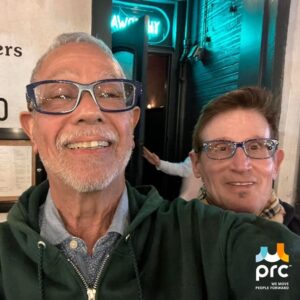AIDS Emergency Fund Continues Serving Clients as PRC’s Emergency Financial Assistance
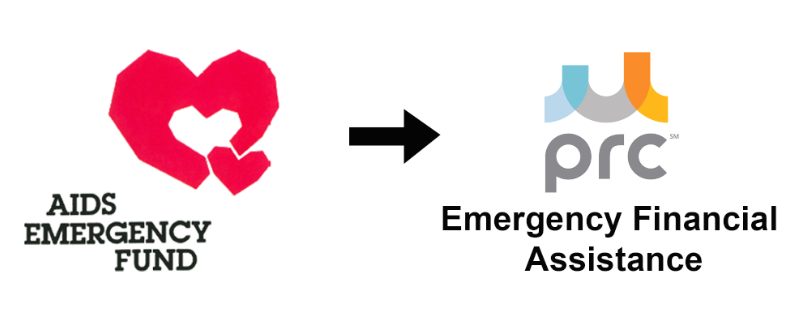
As the city of tolerance and the birthplace of gay rights, San Francisco has been a sanctuary and home to hundreds of thousands of LGBTQ+ individuals since World War II, when many landed here after being dishonorably discharged from the military solely for their sexual orientation. To this day, San Francisco stands as a symbol of hope for gay men, women, and non-binary individuals from less progressive towns throughout the country and the world. Sadly, San Francisco is also one of the cities most heavily impacted by the HIV/AIDS pandemic that has taken the lives of millions and continues to affect countless individuals to this day. At its onset, HIV/AIDS primarily affected gay men, who were not acknowledged or given assistance from the federal government, forcing them to fend for themselves.
It is no surprise, therefore, that San Francisco spearheaded efforts for HIV/AIDS support services and medical advancements. San Franciscans have long been a leading example of how communities can come together to support each other. In the four decades that have passed since the first documented cases of AIDS, many of the grassroots organizations that formed in response have either merged with others or faded into memories. PRC’s Emergency Financial Assistance program has stood the test of time and continues to support the basic financial needs for low-income HIV+ San Francisco residents.
If you were living in San Francisco in the 1980s and 1990s, you probably recall seeing penny jars on the counters of local merchants, bars, restaurants, and offices, politely asking for donations. Simple displays prompted you to leave the change from your purchase or lighten your pockets to support a local cause. It was an effort spawned out of desperation by a community witnessing friend after friend fall victim to the deadliest pandemic of their time. These penny jars meant something, not only to the people wanting to help friends and partners, but to those who relied on these donations to pay for utilities, medical bills, housing, and even funerals. This “Every Penny Counts” grassroots effort was one of the many fundraising tactics utilized by the AIDS Emergency Fund (AEF), now known as PRC’s Emergency Financial Assistance (EFA) program, which has distributed more than $35 million dollars to clients since its founding in 1982.
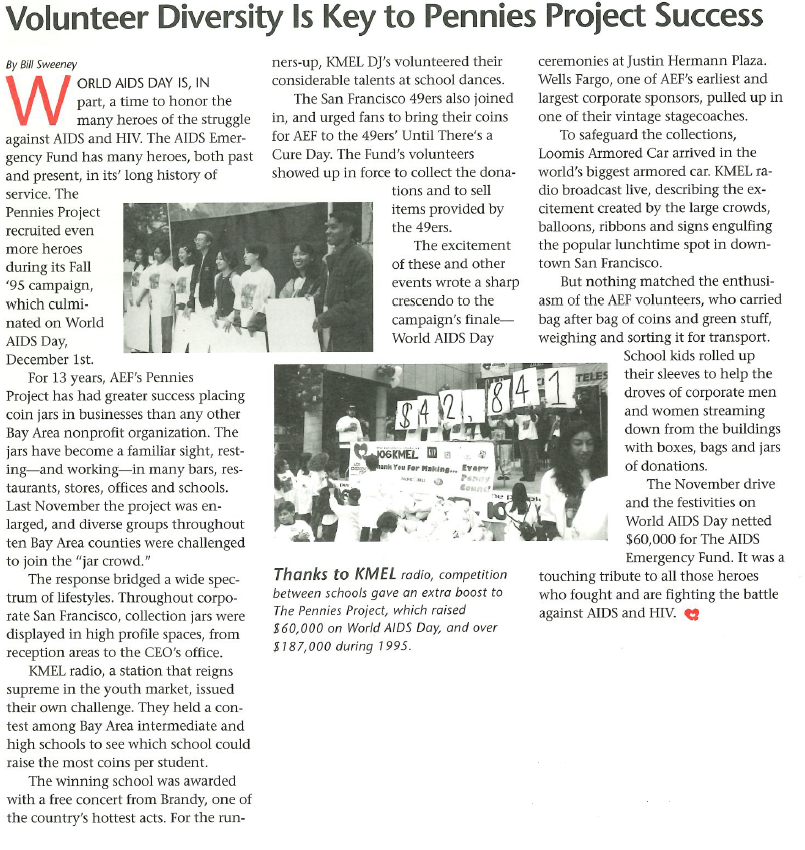
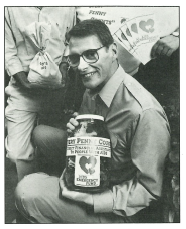
You may wonder how collecting pennies could ever translate into millions of dollars. Also, who collected and counted them, and who decided how much money to give to each person? How much does that amount of coins even weigh? These are all important questions that need to be answered. Starting with the easiest to visualize, 100,000,000 pennies, or $1 million dollars, collectively weigh 551,000 pounds, roughly the equivalent of 16 semi-trucks. Granted, not all the donations came in pennies. Other coins, bills, and checks were also accepted. Still, collecting and counting was no light task.
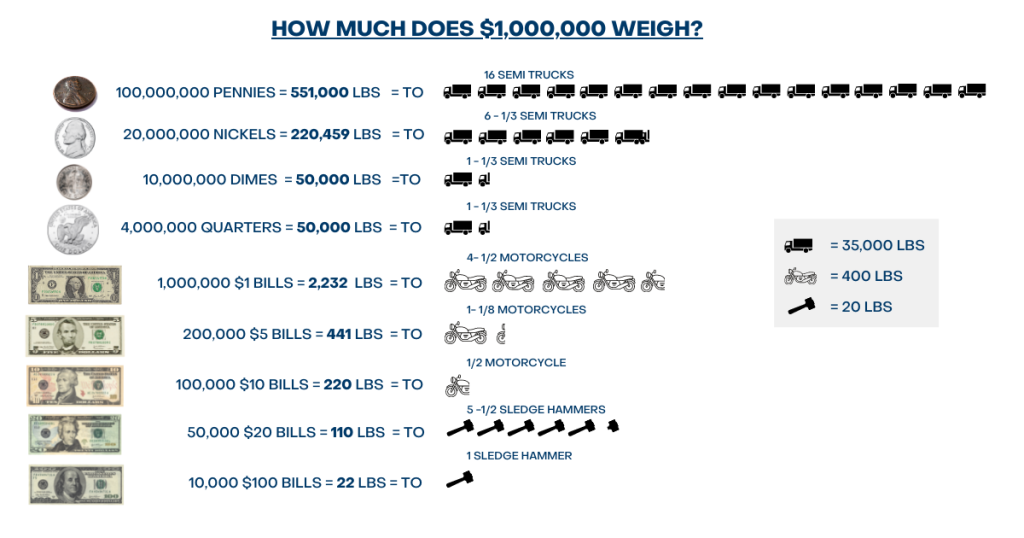
Volunteers were the lifeblood of AEF by delivering empty coin jars around town, picking them up when filled, cleaning and sorting the coins, working directly with recipients of the fund, and writing grant checks. Each year on December 2nd, following World AIDS Day, hundreds of volunteers, sponsors, and even school students would gather in San Francisco’s Justin Herman Plaza, then years later at Union Square, for Every Penny Counts Day to sort and count donations. Bodybuilders from World Gym would do the heavy lifting as coin bags were filled, and Radio station Wild 107 awarded a dance party and a mixer to the top two schools that raised the most pennies per student each year.
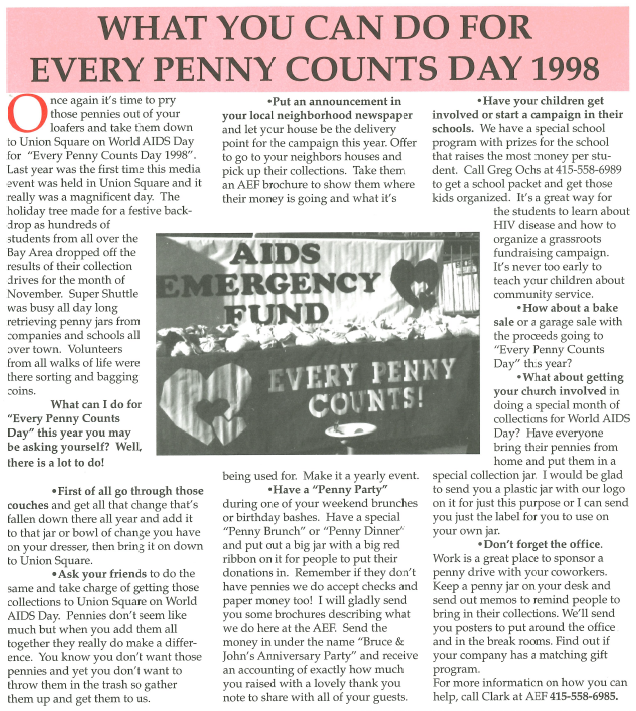
In 1982, AEF’s first year in operation, $6,500 was raised, and by 1992 they were distributing more than $1,000,000 annually in the form of emergency grants to low-income individuals experiencing HIV/AIDS. To qualify for a grant, a client’s monthly income had to be less than $1,456. However, most recipients were living on $900 or less. Each qualifying recipient could receive up to $500 per year with a lifetime benefit of $1,000. Although the grant amounts seem small, they managed to keep people housed, their basic utilities on, and provide some relief to the already overwhelming stresses associated with the debilitating disease. By 1996, EFA was distributing more than $1.6 million annually with 75% going to requests for emergency housing payments, and the remaining 25% supporting utilities, medical bills, and funeral costs.
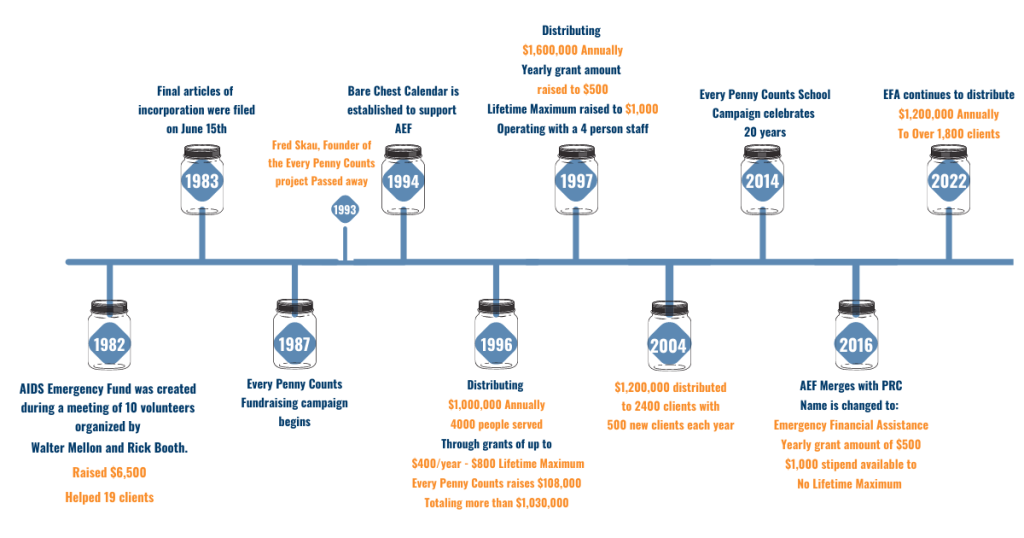
In 1997, AEF operated with a four-person staff, donated furniture, and a phone system that was on its last leg. Still, they stayed true to their mission to assist as many people as possible. AEF was also operating at a deficit and for the first and only time, was forced to reduce grant amounts to $400 per year with a lifetime cap of $800. Grant amounts returned to $500 per year in March of 1998, and clients who had met the reduced lifetime maximum of $800 were informed that they could receive the additional $200.
Providing nearly 4,000 individuals per year with a grant of up to $500 required AEF to raise an additional $500,000 annually, and collecting pennies was not enough. As HIV/AIDS continued taking lives and more people tested positive, the number of individuals needing assistance also continued to grow. Once again, the community responded by creating a variety of fundraising events in bars, homes, and community spaces. Some even put AEF in their wills, their final gift as many joined the ever-growing list of AIDS victims. The creation of the Bare Chest Calendar in 1994 joined the annual AEF Awards Dinner in funneling its proceeds directly to AEF grants. Ambassador James Hormel, who sadly passed last year, announced the Hearts of Gold Campaign at the AEF Awards dinner in 1997, asking the community to pledge recurring yearly donations of $500 or more to help support the growing need.
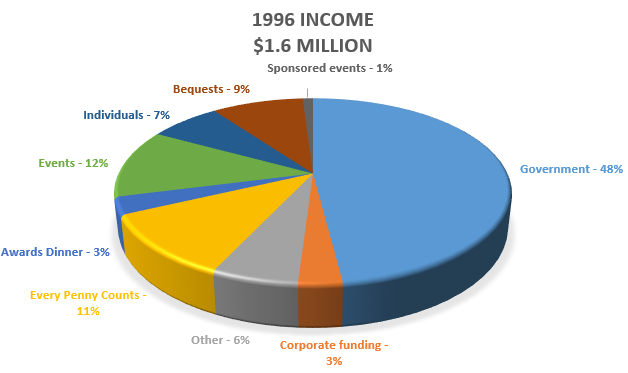

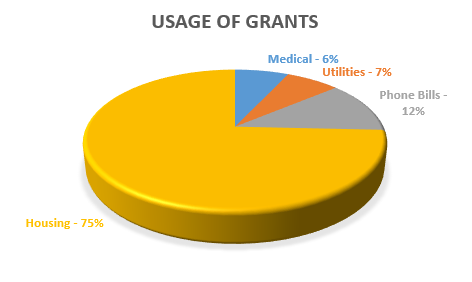
In 2016, AIDS Emergency Fund merged with PRC (at that time known as Positive Resource Center) and was renamed Emergency Financial Assistance (EFA). PRC had been assisting HIV/AIDS clients since 1987 as AIDS Benefits Counselors by offering legal assistance in securing Social Security and disability benefits and helping to navigate through the cumbersome process. The merger was a natural fit for these two organizations serving the same population and provided a continuum of services that clients could move through on their path to better health and financial outcomes.
The need for PRC’s Emergency Financial Assistance continues to this day. To keep up, PRC has grown in its operations and in its fundraising efforts. It now partners with the city and other public funders, foundations, and corporate donors in addition to individual supporters. This growth has helped to secure the funds needed to provide individuals with an annual maximum benefit of $500 with no lifetime maximum, and the possible addition of a $1,000 stipend to assist with a deposit for housing or to prevent an eviction. We are infinitely grateful for the continued support of all our donors who make this grantmaking possible and remain forever thankful to the countless staff and volunteers who helped build AEF and bring it into a new era, all of whom have a lot to be proud of.
If you enjoyed reading about the history of the AIDS Emergency Fund and its transition to become PRC’s Emergency Financial Assistance and would like to support our programs, please consider making a donation. You can learn more about all of PRC’s services on our website.



